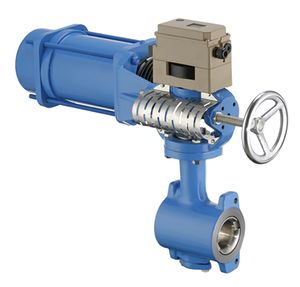Rotary Plug Valves
Rotary Plug Valve is an outstanding combination of Dome Valves, Butterfly Valves, and the classic control valve and unifies all their advantages such as free passage, no dead space, high gland nut insularity, control over high pressure difference, compact design and very good control properties. Rotary plug valves have a variety of critical applications that can only be covered by conventional control valves with difficulty.
One of the main advantages of the rotary plug valve is its free passage. Due to the flow restrictor which moves crossways to the flow, the media current does not have to be diverted through the housing wall. This confers a special advantage on abrasive or adhesive media. The axle’s bearing in connection with the plug and the housing is arranged double eccentric and causes the plug to lift up immediately and smoothly from the seat when rotating the plug shaft. The valve does not fire open and therefore displays stable control action even for small opening angles.Rotary plug valves are characterised by high Kvs values that are up to 200% larger than is the case for hub valves of a similar nominal size. By opting for a rotary plug valve, you can use smaller valve nominal sizes and thereby avail of cheaper solutions. Rotary plug valves display firm geometry of the flow restrictor, whereby the valve’s natural curve is set. Conversion to an ideally linear or ideally equal percentage curve is conducted via a position regulator, either with suitable cam disks or via a software curve in the case of modern regulators. The incoming signal is transformed accordingly via the so-called signal curve so that this produces the desired total curve by superimposing with the natural curve. The high range ability of the rotary plug valve must be mentioned in connection wtih the flow curve.The range ability defines the ratio of the nominal-Kvs-value to the smallest controllable flow value where the curve is still within the permitted tolerances. Rotary plug valves attain typical values of 1:200 in comparison with hub valves with range abilities of 1:30 to 1:50. The rotary plug’s valves are pre-determined by the design, because the plug does not dip into the seat through the double eccenter, but releases a traceable transverse section for the smallest opening angle. Therefore, in the case of a rotary plug valve, it can be adjusted to zero.
In contrast with the hub valves, rotary plug valves produce a torque through the actuator’s linear transmission via a lever which favours the use of smaller Actuators with shorter manipulation. This can be seen, most notably, in the case of large nominal sizes. Compared to hub valves, rotary plug valves have a more compact design.
